Table of Contents
APEC Leaders’ Summit 2023
The United States hosted the annual APEC Summit 2023 of world leaders on November 11-17, 2023 for the first time since 2011. San Francisco was honoured as the Host City for the Asia-Pacific Economic Cooperation (APEC) Leaders’ Week 2023 with the theme of “Creating a Resilient and Sustainable Future for All.” The 2023 Asia Pacific Economic Cooperation (APEC) summit was a notable event in diplomacy, as it saw the United States and China reestablishing dialogue after almost a year of silence. The APEC Leaders’ Summit 2023 concluded with the adoption of the Golden Gate Declaration.
- The Golden Gate Declaration underscores the commitment to creating a resilient and sustainable future for all APEC member economies.
In the International Relations section of UPSC GS Paper 2 for the Preliminary and Main exams, Asia Pacific Economic Cooperation, or APEC, is a significant subject. We go through all of APEC’s subtopics in this article, including its history, members, goals, criticism, FTAAP, etc., in great detail. The Asia Pacific Economic Cooperation (APEC) Question from the Previous Year has also been discussed.
We’re now on WhatsApp. Click to Join
Asia-Pacific Economic Cooperation (APEC)
It was formally established in 1989 with 12 members ( Australia; Brunei Darussalam; Canada; Indonesia; Japan; Korea; Malaysia; New Zealand; the Philippines; Singapore; Thailand; and the United States). Currently, it has 21 member economies of the Pacific Rim. (China; Hong Kong, China; and Chinese Taipei in 1991, Mexico and Papua New Guinea 1993, Chile 1994, Peru; Russia and Vietnam in 1998).
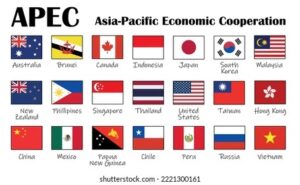
Reasons for Establishment of APEC Forum
The establishment of APEC was largely driven by the growing mutual reliance among economies in the Asia-Pacific region.
- Additionally, the rise of regional economic groupings, such as the European Union (EU) and the now-dissolved North American Free Trade Area (NAFTA), played a significant role in its inception.
- During the 1994 summit in Bogor, Indonesia, APEC established the Bogor Goals, which aimed for “free and open trade and investment in the Asia-Pacific by 2010 for advanced economies and by 2020 for emerging economies.”
- Contribution: The member countries collectively account for nearly 50% of the world’s trade and 62% of GDP
A significant multilateral economic trade forum is the Asia Pacific Economic Cooperation. As a regional economic conference, APEC was created to promote stronger economic ties and long-term development among its member nations. Free trade and investment are guaranteed for members of the international intergovernmental organisation without any involvement in legally obligatory obligations. The APEC member countries collectively account for nearly 50% of the world’s trade and 62% of GDP.
Objectives of APEC Forum
The main goals are to create a discussion forum for a variety of economic topics and to encourage multilateral collaboration among the market-oriented economies in the region.
By encouraging the movement of commodities, services, capital, and technology; creating a regime of liberalised trade and investment; encouraging private investment; and fostering “open regionalism,” APEC specifically seeks to enhance economic and technological collaboration among the members. Furthermore, it aims to hasten and advance regional economic integration. The organisations work to foster a positive and long-lasting corporate environment by improving human security.
- Free and open trade and investment
- Accelerate regional economic integration
- Encourage economic and technical cooperation
- Enhance human security
- Facilitate a favourable and sustainable business environment.
Asia-Pacific Economic Cooperation (APEC) Background
The idea for a permanent organisation was put forth by Australia’s then-prime minister, Robert Hawke, in January 1989. In light of the Pacific Rim countries’ market-based economies, he made this offer to facilitate improved commercial connections. The Pacific Economic Cooperation Council (PECC), which was composed of businesspeople, academics, and representatives of governments, also backed this concept.
Since 1980, the informal debate has also been held by the Pacific Economic Cooperation Council. Australia, Canada, Japan, New Zealand, and the United States were the five industrialised economies of the Pacific that attended the first APEC meeting. In November 1989, the Association of Southeast Asian Nations (ASEAN) meeting—which included representatives from Indonesia, Malaysia, Thailand, Singapore, the Republic of Korea, Brunei, and South Korea—took place in Canberra, Australia.
Due to concerns over the dominance of sophisticated nations like the USA, Canada, Australia, New Zealand, and Japan, the Association of Pacific Economic Cooperation (APEC) meeting had hitherto remained informal and unstructured. The nations of ASEAN preferred that non-Asian nations be excluded from East Asian economic organisations. As the process of regional integration and economic liberalisation progressed and became important for economic development and security in the post-Cold War era, they gradually began to embrace the concept.
The Asia Pacific Economic Cooperation was given a clear goal and organisational framework at the ministerial summit held in Seoul, South Korea, in 1991. Taiwan, Hong Kong, and China were also members of APEC. The institutionalization of the APEC was finally finished in 1992 when the Bangkok ministerial meeting decided to establish a permanent Secretariat in Singapore.
Asia Pacific Economic Cooperation (APEC) Structural Setup
A Secretariat, Senior Officials Meetings, Working Groups, and Annual Ministerial Meetings make up APEC. The Annual Ministerial Meeting of the foreign and trade ministers of all the member states serves as the governing body of APEC. Each year, a different member serves as meeting chairman. The Senior Officials Meetings, which are conducted yearly and include representatives from every member state, are in charge of putting the policies created by Ministerial Meetings into action.
Ten working groups, including two ad hoc ones, are involved in regional trade liberalization and economic policy. The other two working groups are concerned with telecommunications, trade and investment data, fisheries, tourism, transportation, trade promotion, investment, and technology, human resource development, and regional energy cooperation. The Executive Director of the Secretariat has a one-year term and is in charge of the organisation.
APEC Summits From 1989-2023
Check Below for the complete details of the APEC Summits like where it happened, when it happened, the Leader of the Host etc.
| Year | Dates | Country | City | Leader of Host |
| 1989 | 6-7 November | Australia | Canberra | Prime Minister Bob Hawke |
| 1990 | 29-31 July | Singapore | Singapore | Prime Minister Lee Kuan Yew |
| 1991 | 12-14 November | South Korea | Seoul | President Roh Tae-woo |
| 1992 | 10-11 September | Thailand | Bangkok | Prime Minister Anand Panyarachun |
| 1993 | 19-20 November | United States | Blake Island | President Bill Clinton |
| 1994 | 15-16 November | Indonesia | Bogor | President Suharto |
| 1995 | 18-19 November | Japan | Osaka | Prime Minister Tomiichi Murayama |
| 1996 | 24-25 November | Philippines | Subic | President Fidel Ramos |
| 1997 | 24-25 November | Canada | Vancouver | Prime Minister Jean Chrétien |
| 1998 | 17-18 November | Malaysia | Kuala Lumpur | Prime Minister Mahathir Mohamad |
| 1999 | 12-13 September | New Zealand | Auckland | Prime Minister Jenny Shipley |
| 2000 | 15-16 November | Brunei | Bandar Seri Begawan | Sultan Hassanal Bolkiah |
| 2001 | 20-21 October | China | Shanghai | President Jiang Zemin |
| 2002 | 26-27 October | Mexico | Los Cabos | President Vicente Fox |
| 2003 | 20-21 October | Thailand | Bangkok | Prime Minister Thaksin Shinawatra |
| 2004 | 20-21 November | Chile | Santiago | President Ricardo Lagos |
| 2005 | 18-19 November | South Korea | Busan | President Roh Moo-hyun |
| 2006 | 18-19 November | Vietnam | Hanoi | President Nguyễn Minh Triết |
| 2007 | 8-9 September | Australia | Sydney | Prime Minister John Howard |
| 2008 | 22-23 November | Peru | Lima | President Alan Garcia Perez |
| 2009 | 14-15 November | Singapore | Singapore | Prime Minister Lee Hsien Loong |
| 2010 | 13-14 November | Japan | Yokohama | Prime Minister Naoto Kan |
| 2011 | 12-13 November | United States | Honolulu | President Barack Obama |
| 2012 | 9-10 September | Russia | Vladivostok | President Vladimir Putin |
| 2013 | 5-7 October | Indonesia | Bali | President Susilo Bambang Yudhoyono |
| 2014 | 10-11 November | China | Beijing | President Xi Jinping |
| 2015 | 18-19 November | Philippines | Pasay | President Benigno Aquino III |
| 2016 | 19-20 November | Peru | Lima | President Pedro Pablo Kuczynski |
| 2017 | 10-11 November | Vietnam | Da Nang | President Trần Đại Quang |
| 2018 | 17-18 November | Papua New Guinea | Port Moresby | Prime Minister Peter O’Neill |
| 2019 | 16-17 November (cancelled) | Chile | Santiago | President Sebastián Piñera |
| 2020 | 20 November | Malaysia | Kuala Lumpur (hosted virtually) | Prime Minister Muhyiddin Yassin |
| 2021 | 16 July | New Zealand | Auckland (hosted virtually) | Prime Minister Jacinda Ardern |
| 12 November | ||||
| 2022 | 18-19 November | Thailand | Bangkok | Prime Minister Prayut Chan-o-cha |
| 2023 | 11-17 November | USA | San Francisco |
Asia Pacific Economic Cooperation (APEC) Member Countries
Australia, Canada, Japan, Malaysia, Philippines, USA, Thailand, Singapore, Brunei, Darussalam, Indonesia, South Korea, New Zealand, Hong Kong, Chinese Taipei, China, Mexico, Papua New Guinea, Chile, Russia, Peru, and Vietnam are the 21 members of the Pacific Rim who make up the Asia Pacific Economic Cooperation.
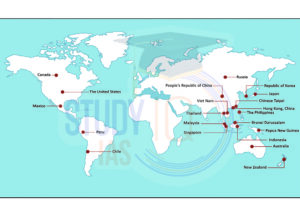
India had initially received support for its application to join the Asia Pacific Economic Cooperation from the United States, Japan, and Papua New Guinea. However, because India does not share a land border with the Pacific Oceans with the other current members of the organisation, India was not granted membership. In November 2011, India received an invitation to attend APEC for the first time as an observer.
APEC and India
India is not a member of the forum and currently has the ‘observer’ status. In 1991, coinciding with the introduction of economic liberalisation in India, the country applied to join the APEC group. While numerous members supported India’s inclusion, some opposed it, pointing to India’s economic reforms and alleged ‘protectionist instincts’. A membership freeze, implemented in 1997, further hindered India’s entry into APEC. This freeze, however, was lifted in 2012.
The main goals of APEC’s initiatives have been to streamline regulatory frameworks, lower trade and investment obstacles, and foster an environment of economic openness, cooperation, and dialogue. APEC has long piqued India’s interest. It made an unsuccessful application for APEC membership in the late 1990s, but due to a 1997 ban on new members, the application was not taken into consideration.
Integrating an economy the size of India would be a significant step towards Asia-Pacific regional connectivity. Over the past 25 years, India has been a significant recipient of FDI from APEC members, with three APEC economies—Singapore, Japan, and the United States—ranking among the top five sources of FDI inflows into India.
India was the ninth-biggest global recipient of FDI in 2014 and the fifteenth-largest the year prior. However, in the first half of 2015, an improvement in investment-friendly laws has helped India become the world’s top Greenfield FDI destination.
Why APEC Crucial For India?
Greater Economic Integration: India’s entry into APEC would provide a pathway for more substantial integration into the region’s economy.
- For example: India has been expanding trade and investment ties with the region, especially through agreements like the India–ASEAN Free Trade Agreement and Comprehensive Economic Cooperation Agreements with Singapore and Malaysia.
- APEC membership would mark an important step towards India opening to increased trade and investment and preparing for inclusion in larger trade pacts like the Trans-Pacific Partnership (TPP).
Asia Pacific Economic Cooperation: Proposal of FTAAP
Due to the lack of progress in the WTO port round of negotiations and the need to avoid the “noodle bowl” effect caused by overlapping and conflicting provisions of the numerous trade agreements (there were about 60 trade agreements in 2007 with an additional 117 under negotiation in the region and therefore the Asia-Pacific region), the Free Trade Agreement of the Asia Pacific (FTAAP) proposal was made. There were 339 trade agreements between the ASEAN+6 countries alone in 2012, and many of them were bilateral.
The FTAAP has a wider scope than the port round, which focuses only on easing trade constraints. The FTAAP would create a trading zone that may greatly increase regional trade and economic activity. The Association of Southeast Asian Nations and 3 (ASEAN + China, South Korea, and Japan) and other regional trading areas may be surprised by the economic growth and trade expansion. Some objections include the claims that the rerouting of commerce among APEC members will result in trade imbalances, market conflicts, and difficulties with countries in other areas.
It is envisaged that the FTAAP will take place over a period of several years and involve important studies, assessments, and negotiations between member economies. It is further hampered by the lack of effective political activism and lobbying against trade in domestic politics. Five of the twenty-one APEC countries have expressed interest in joining the Trans-Pacific Partnership, which currently has twelve of the twenty-one APEC members.
Asia Pacific Economic Cooperation (APEC) Criticism
The Free Trade Agreement of the Asia Pacific (FTAAP) proposal was made in an effort to resolve the competing and overlapping aspects of the Free Trade Agreement against the backdrop of the Doha round of negotiations in the World Trade Organisation. By 2007, more than 60 FTAs had previously been completed, and over 117 FTAs were now being negotiated in Southeast Asia and the Asia Pacific area.
To promote trade, commerce, and economic development in the region, the Free Trade Agreement of the Asia Pacific (FTAAP) was intended to establish a Free Trade Zone. However, there was no political interest in moving further because of the public agitation and lobbying against the Free Trade Agreement in domestic politics.
Asia Pacific Economic Cooperation (APEC) UPSC
The Asia-Pacific Economic Cooperation (APEC) is a regional economic organization that is crucial for UPSC aspirants to understand. It is the world’s largest regional economic grouping, accounting for approximately 40% of global trade and 60% of the world’s GDP. APEC’s role in promoting trade and economic cooperation in the Asia-Pacific region makes it an important topic for the UPSC exam.

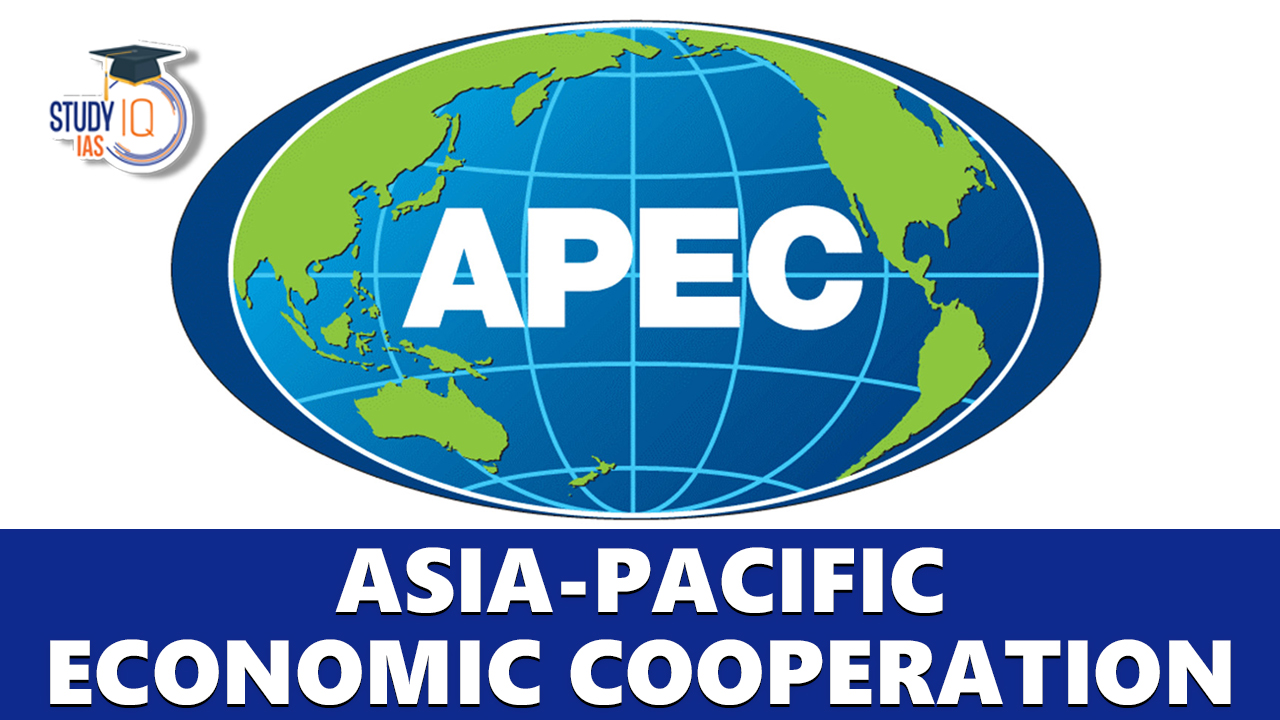
 NATO Countries List 2025, Members, Funct...
NATO Countries List 2025, Members, Funct...
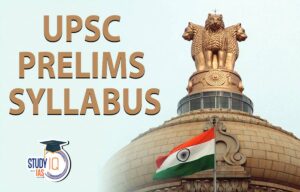 UPSC Prelims Syllabus 2025 PDF, Check Su...
UPSC Prelims Syllabus 2025 PDF, Check Su...
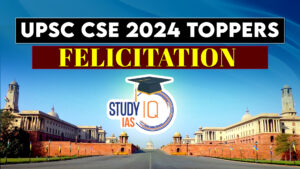 UPSC Toppers 2024 Felicitation Program b...
UPSC Toppers 2024 Felicitation Program b...





















